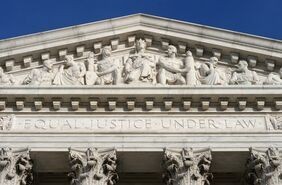Patent Eligibility Restoration Act of 2023—What In-House Counsel Need to Know
What You Need to Know
Key takeaway #1
The scope of inventions eligible to be protected by patents in the U.S. will be expanded by proposed legislation overruling the judicial exceptions to patent eligibility, in both life sciences and computer-related technologies.
Key takeaway #2
Those involved in protecting inventions will want to study these changes and plan for expanded patent filings if this is signed into law.
Client Alert | 4 min read | 07.20.23
On June 22, 2023, U.S. Senators Thom Tillis (R-NC) and Chris Coons (D-DE) introduced the Patent Eligibility Restoration Act of 2023 (“the Bill”), aiming to restore patent eligibility to important inventions across many fields. Essentially, the Bill is trying to eliminate judicial exceptions to patent eligibility, and provide clear guidance on determining patent eligibility, especially in areas such as medical diagnostics, biotechnology, personalized medicine, artificial intelligence, 5G, and blockchain. The U.S. Supreme Court has established several judicial exceptions to subject matter eligible for patenting. Although these exceptions are not enumerated in the statute, the Supreme Court has interpreted 35 U.S.C. § 101 to exclude subject matter from being patented if it falls within any of three areas: natural phenomena, laws of nature and abstract ideas. Alice Corp. v. CLS Bank International, 573 U.S. 208 (2014). These judicial exceptions frustrate many IP owners around the world, because many inventions that are eligible for patents in other countries cannot be patented in the U.S. or are ruled invalid in U.S. courts. Moreover, supporters of this bill argue that leading-edge technologies that give U.S. industry competitive advantages over foreign companies have been difficult to patent in the U.S. under the Court’s rulings. This legislation reportedly has a good chance to pass in this Congressional session, and companies need to be prepared for the dramatic changes if it becomes law.
Summary of Patent Eligible Subject Matter and Exceptions
To overrule the judicial exceptions to patent eligibility, the Bill states, “Any invention or discovery that can be claimed as a useful process, machine, manufacture, or composition of matter, or any useful improvement thereof, is eligible for patent protection,” except what is explicitly provided in amended 35 U.S.C. § 101. A “useful” invention has a broad meaning. The Bill states, “The term ‘useful’ means . . . that the invention or discovery has a specific and practical utility from the perspective of a person of ordinary skill in the art to which the invention or discovery pertains.”
The Bill also sets forth the limited exceptions to patent eligibility:
- “[a] mathematical formula that is not part of an invention”;
- “a process that is substantially economic, financial, business, social, cultural, or artistic”;
- “[a] process that ‘(i) is a mental process performed solely in the human mind’; or ‘(ii) occurs in nature wholly independent of, and prior to, any human activity’”;
- “[an] unmodified human gene, as that gene exists in the human body”; and
- “[an] unmodified natural material, as that material exists in the nature.”
Guidance Related to Computer-related Inventions
Currently, it has been challenging to obtain patents on computer-related inventions, such as artificial intelligence. According to the Bill, “any process that cannot be practically performed without the use of a machine (including a computer) or manufacture shall be eligible for patent coverage.” There are exceptions, however. A “process that is substantially economic, financial, business, social, cultural, or artistic” is not patent eligible, “even though not less than 1 step in the process refers to a machine or manufacture.” Furthermore, “process claims drawn solely to the steps undertaken by human beings in methods of doing business, performing dance moves, offering marriage proposals, and the like shall not be eligible for patent coverage, and adding a non-essential reference to a computer by merely stating, for example, ‘do it on a computer’ shall not establish [patent] eligibility.”
Guidance Related to Biotechnology
Currently, it has been a challenge to obtain patents on discoveries of applications of genetic material and medicines derived from natural products. As to the exceptions related to unmodified human gene and unmodified natural material, the Bill clarifies that “a human gene or natural material shall not be considered to be unmodified if the gene or material” is “isolated, purified, enriched, or otherwise altered by human activity” or “otherwise employed in a useful invention or discovery.” This change appears to put the standard on equal footing with many non-U.S. countries.
Guidance on Determining Patent Eligibility
Many recent judicial decisions have found patents invalid as not being directed to patent eligible subject matter by apparently ignoring elements of the claimed invention, dismissing claim elements as conventional, or conflating the analysis with other requirements for patentability. The proposed legislation intends to stop this judicial handwaving of the claimed details. “In determining whether . . . a claimed invention is eligible for a patent,” the Bill states, “eligibility shall be determined . . . by considering the claimed invention as a whole and without discounting or disregarding any claim elements” and without regard to: 1) “the manner in which the claimed invention was made;” 2) “whether a claim element is known, conventional, routine, or naturally occurring;” 3) “the state of the applicable art, as of the date on which the claimed invention is invented;” or 4) “any other consideration in section 102, 103, or 112.”
Anyone with an interest in patents and inventions should be prepared for dramatic changes. It has been reported that Senators Tillis and Coons are determined to see this legislation get passed during this Congressional session, and there reportedly is big support by industry. Companies should consider budgeting for increased patent filings for inventions that were previously considered of marginal patent eligibility. For patent applications covering important inventions that have been rejected under 35 U.S.C. § 101, if the rejections cannot be overcome, applicants should consider slowing down examination until the legislation is signed into law. For example, appealing the rejection to the PTAB may add about two years for the process. Refiling the patent application as a continuation application may add a year. For patent litigation, patent owners facing potential challenges on patent eligibility defenses may wish to delay the litigation and/or select venues with slower dockets to give sufficient time to see if the proposed legislation will be signed into law and the final statutory language.
Contacts
Insights
Client Alert | 9 min read | 01.06.26
Beyond the Checkout: Retail's 2026 Legal Minefield
2026 will be a significant year for retailers and e-commerce companies, with significant changes on the horizon that will affect the entire industry and ecosystem. Potential headwinds and developments in product safety, pricing, artificial intelligence, data privacy, website compliance, and environmental responsibility are expected. But amidst these changes, there are likely significant opportunities that retail and e-commerce businesses can capitalize on.
Client Alert | 6 min read | 01.06.26
California Privacy Agency Launches Data Broker Strike Force Amid Delete Act Crackdown
Client Alert | 4 min read | 01.05.26
Another Court Rules CASA Does Not Limit Universal Relief Available Under the APA
Client Alert | 7 min read | 01.05.26
Consideration of Artificial Intelligence in Arbitration Terms of Reference




